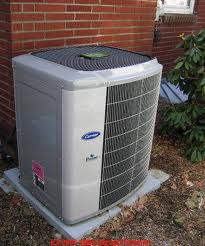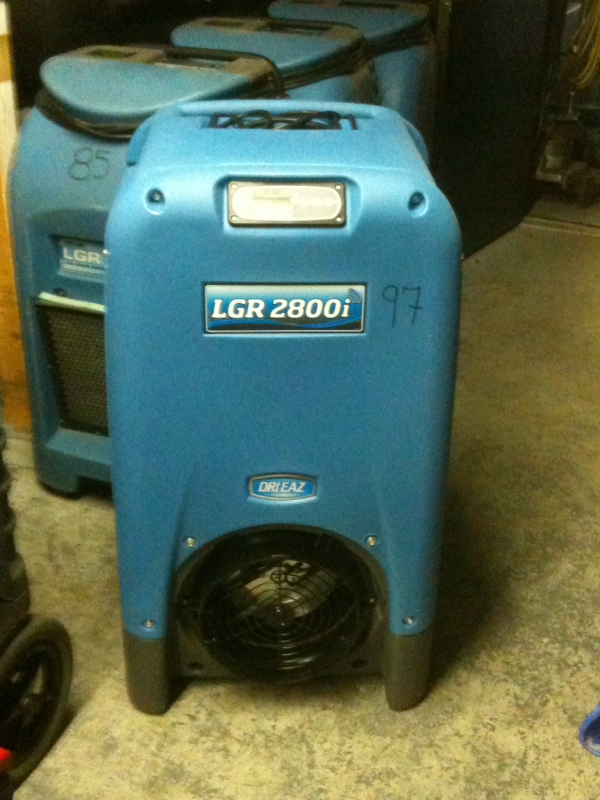After the torrential rains this past summer, I was called to a flood job in Brookline MA. Upon arriving, I found the entire finished basement had water damage. The home owner was unsure as to where the water had come from. He said he never had a problem with a wet basement in the past. After my technicians extracted the water, they found that water was seeping in thru a crack on the floor. I showed the owner where the water was coming from and explained that “because this was not a pipe break, unfortunately, it probably would not be covered by insurance.” (But I did suggest that he call his insurance agent to be su re).
re).
 re).
re). Next, I figured out the amount of equipment needed to dry out the home so I could give the home owner an estimation of what it would cost. After giving him a price, the home owner asked me a great question “what is the difference between AC and a Dehumidifier?” “Because central air conditioner removes humidity, right?” The home owner thought that he could save a little money by not renting a dehumidifier.
I explained to him that the difference between AC and a dehumidifier is not very great. An air conditioner like a dehumidifier pulls warm moist air over its cold coils; the difference is that AC does not reheat the air before exhausting into your home. What you get is nice cold air blowing out of the Air conditioning unit. It also doesn’t have a humidistat, so when the home reaches a preset temperature the AC will shut down, even though your home may still have high humidity. But more importantly, depending on when you turn on the air conditioner, it may do more harm than good. For example if the temperature in your flooded home is 74⁰ degrees Fahrenheit and the relative humidity (RH) is 90% and you turn on the air conditioning system, when the cool air coming out hits the dew point at about 70⁰ degrees it’s going to start raining (condensation) all over the inside of your home. So it’s best to use a dehumidifier and not an air conditioning to help dry out your home. The dehumidifiers job is solely to remove humidity.
exhausting into your home. What you get is nice cold air blowing out of the Air conditioning unit. It also doesn’t have a humidistat, so when the home reaches a preset temperature the AC will shut down, even though your home may still have high humidity. But more importantly, depending on when you turn on the air conditioner, it may do more harm than good. For example if the temperature in your flooded home is 74⁰ degrees Fahrenheit and the relative humidity (RH) is 90% and you turn on the air conditioning system, when the cool air coming out hits the dew point at about 70⁰ degrees it’s going to start raining (condensation) all over the inside of your home. So it’s best to use a dehumidifier and not an air conditioning to help dry out your home. The dehumidifiers job is solely to remove humidity.
 exhausting into your home. What you get is nice cold air blowing out of the Air conditioning unit. It also doesn’t have a humidistat, so when the home reaches a preset temperature the AC will shut down, even though your home may still have high humidity. But more importantly, depending on when you turn on the air conditioner, it may do more harm than good. For example if the temperature in your flooded home is 74⁰ degrees Fahrenheit and the relative humidity (RH) is 90% and you turn on the air conditioning system, when the cool air coming out hits the dew point at about 70⁰ degrees it’s going to start raining (condensation) all over the inside of your home. So it’s best to use a dehumidifier and not an air conditioning to help dry out your home. The dehumidifiers job is solely to remove humidity.
exhausting into your home. What you get is nice cold air blowing out of the Air conditioning unit. It also doesn’t have a humidistat, so when the home reaches a preset temperature the AC will shut down, even though your home may still have high humidity. But more importantly, depending on when you turn on the air conditioner, it may do more harm than good. For example if the temperature in your flooded home is 74⁰ degrees Fahrenheit and the relative humidity (RH) is 90% and you turn on the air conditioning system, when the cool air coming out hits the dew point at about 70⁰ degrees it’s going to start raining (condensation) all over the inside of your home. So it’s best to use a dehumidifier and not an air conditioning to help dry out your home. The dehumidifiers job is solely to remove humidity.There are times however when an air conditioning system can help if certain conditions are present. But this should be left up to a water damage restoration professional to monitor the home’s environment to determine when it is the best time to turn on and off the AC unit.
In conclusion the difference between an AC and a dehumidifier is not much, but the usefulness of each system can be quite different in each situation.
Water Damage Local.com is available 24/7 to handle all of your water restoration needs.